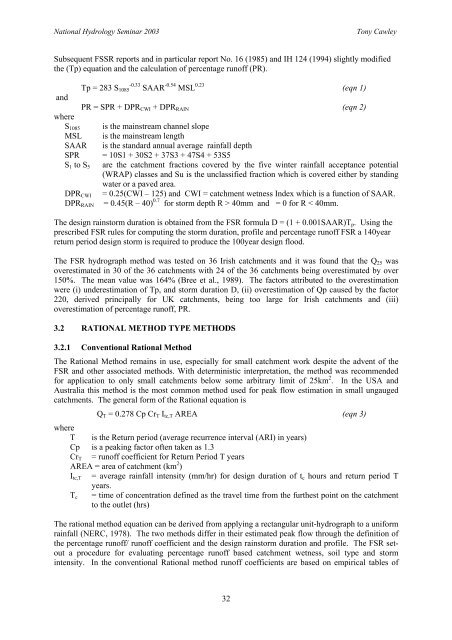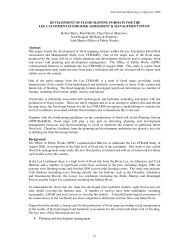COMMENT ON ESTIMATION OF GREENFIELD RUNOFF RATES ...
COMMENT ON ESTIMATION OF GREENFIELD RUNOFF RATES ...
COMMENT ON ESTIMATION OF GREENFIELD RUNOFF RATES ...
You also want an ePaper? Increase the reach of your titles
YUMPU automatically turns print PDFs into web optimized ePapers that Google loves.
National Hydrology Seminar 2003<br />
Tony Cawley<br />
Subsequent FSSR reports and in particular report No. 16 (1985) and IH 124 (1994) slightly modified<br />
the (Tp) equation and the calculation of percentage runoff (PR).<br />
Tp = 283 S -0.33 1085 SAAR -0.54 MSL 0.23 (eqn 1)<br />
and<br />
PR = SPR + DPR CWI + DPR RAIN (eqn 2)<br />
where<br />
S 1085 is the mainstream channel slope<br />
MSL is the mainstream length<br />
SAAR is the standard annual average rainfall depth<br />
SPR = 10S1 + 30S2 + 37S3 + 47S4 + 53S5<br />
S 1 to S 5 are the catchment fractions covered by the five winter rainfall acceptance potential<br />
(WRAP) classes and Su is the unclassified fraction which is covered either by standing<br />
water or a paved area.<br />
DPR CWI = 0.25(CWI – 125) and CWI = catchment wetness Index which is a function of SAAR.<br />
DPR RAIN = 0.45(R – 40) 0.7 for storm depth R > 40mm and = 0 for R < 40mm.<br />
The design rainstorm duration is obtained from the FSR formula D = (1 + 0.001SAAR)T p . Using the<br />
prescribed FSR rules for computing the storm duration, profile and percentage runoff FSR a 140year<br />
return period design storm is required to produce the 100year design flood.<br />
The FSR hydrograph method was tested on 36 Irish catchments and it was found that the Q 25 was<br />
overestimated in 30 of the 36 catchments with 24 of the 36 catchments being overestimated by over<br />
150%. The mean value was 164% (Bree et al., 1989). The factors attributed to the overestimation<br />
were (i) underestimation of Tp, and storm duration D, (ii) overestimation of Qp caused by the factor<br />
220, derived principally for UK catchments, being too large for Irish catchments and (iii)<br />
overestimation of percentage runoff, PR.<br />
3.2 RATI<strong>ON</strong>AL METHOD TYPE METHODS<br />
3.2.1 Conventional Rational Method<br />
The Rational Method remains in use, especially for small catchment work despite the advent of the<br />
FSR and other associated methods. With deterministic interpretation, the method was recommended<br />
for application to only small catchments below some arbitrary limit of 25km 2 . In the USA and<br />
Australia this method is the most common method used for peak flow estimation in small ungauged<br />
catchments. The general form of the Rational equation is<br />
Q T = 0.278 Cp Cr T I tc,T AREA (eqn 3)<br />
where<br />
T is the Return period (average recurrence interval (ARI) in years)<br />
Cp is a peaking factor often taken as 1.3<br />
Cr T = runoff coefficient for Return Period T years<br />
AREA = area of catchment (km 2 )<br />
I tc,T = average rainfall intensity (mm/hr) for design duration of t c hours and return period T<br />
years.<br />
T c = time of concentration defined as the travel time from the furthest point on the catchment<br />
to the outlet (hrs)<br />
The rational method equation can be derived from applying a rectangular unit-hydrograph to a uniform<br />
rainfall (NERC, 1978). The two methods differ in their estimated peak flow through the definition of<br />
the percentage runoff/ runoff coefficient and the design rainstorm duration and profile. The FSR setout<br />
a procedure for evaluating percentage runoff based catchment wetness, soil type and storm<br />
intensity. In the conventional Rational method runoff coefficients are based on empirical tables of<br />
32

















